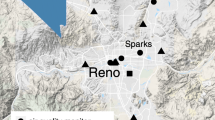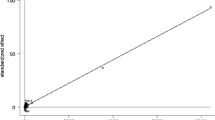Abstract
Exposure to particulate matter less than 2.5 μm in diameter (PM2.5) exacerbates asthma and increases mortality. In Phoenix, AZ, the highest PM2.5 values frequently occur during the winter fireplace season and air quality health standards are often exceeded during the Christmas and New Year’s holidays. It was clear that enhanced messaging was needed by air quality and public health authorities to discourage biomass fires (BMF) on days when unhealthful levels of pollution were likely to be caused by that activity. Demonstrating adverse health outcomes would bolster this effort. We conducted this study to evaluate associations between elevated PM2.5 exposures during the fireplace season and asthma-related hospital admissions in Phoenix; days with average PM2.5 > 35 μg/m3 were categorized as elevated PM2.5 exposure. We used hospital discharge data to identify patients with an asthma-related hospital encounter and who lived within an 8-km radius of a PM2.5 monitor. To estimate the risk of a hospital encounter following an elevated PM2.5 event, we used generalized estimating equations, specified with a Poisson distribution, and exposure lags of 0–3 days. Controlling for influenza, temperature, humidity, rain, and year, these analyses generated elevated estimates of emergency department visit risk among adults on lag days 2 (relative risk [RR] 1.19; 95 % CI 1.06, 1.34) and 3 (RR 1.20, 95 % CI 1.05, 1.37). Elevated PM2.5 was not associated with hospital encounters among children. Our findings suggest that adults may be at elevated risk of asthma-related hospital encounters during the fireplace season.

Similar content being viewed by others
Notes
Arizona Revised Statutes §§9–500.16 and 11–875 requires all homes in the Phoenix air pollution control area built after 1998 to comply with clean-burning fireplace standards, e.g., EPA-certified permanently installed gas or electric log inserts.
References
ADEQ (2001) The governor’s brown cloud summit, appendix 3—sources of fall and winter visibility impairment in Phoenix. Arizona Department of Environmental Quality. http://azmemory.azlibrary.gov/cdm/ref/collection/statepubs/id/5723. Accessed July 21, 2016
ADEQ (2013) Arizona Department of Environmental Quality annual reports. http://www.azdeq.gov/function/forms/reports.html. Accessed September 5, 2013
Akinbami LJ, Moorman JE, Bailey C, Zahran HS, King M, Johnson CA, Liu, X (2012) Trends in asthma prevalence, health care use, and mortality in the United States, 2001–2010. NCHS data brief, no 94, Hyattsville, MD: National Center for Health Statistics
Andersen ZJ, Wahlin P, Raaschou-Nielsen O, Scheike T, Loft S (2007) Ambient particle source apportionment and daily hospital admissions among children and elderly in Copenhagen. J Expo Sci Environ Epidemiol 17(7):625–636
Andersen ZJ, Wahlin P, Rasschou-Nielsen O, Ketzel M, Scheike T, Loft S (2008) Size distribution and total number concentration of ultrafine and accumulation mode particles and hospital admissions in children and the elderly in Copenhagen, Denmark. Occup Environ Med 65(7):458–466
Anderson JO, Thundiyil JG, Stolbach A (2012) Clearing the air: a review of the effects of particulate matter air pollution on human health. J Med Toxicol 8(2):166–175
Antó JM (2012) Recent advances in the epidemiologic investigation of risk factors for asthma: a review of the 2011 literature. Curr Allergy Asthma Rep 12(3):192–200
Barnett SBL, Nurmagambetov TA (2011) Costs of asthma in the United States: 2002-2007. J Allergy Clin Immunol 127(1):145–152
Barry AC, Mannino DM, Hopenhayn C, Bush H (2010) Exposure to indoor biomass fuel pollutants and asthma prevalence in southeastern Kentucky: results from the burden of lung disease (BOLD) study. J Asthma 47(7):735–741
Bell ML, Levy JK, Lin Z (2008) The effect of sandstorms and air pollution on cause-specific hospital admissions in Taipei, Taiwan. Occup Environ Med 65(2):104–111. doi:10.2307/25835163
Bloom B, Cohen RA, Freeman G (2012) Summary health statistics for U.S. children: National Health Interview Survey, 2011. National Center for Health Statistics Vital and Health Statistics 10 (254) (Number 254)
CDC Vital Signs (2011) Asthma in the US. Center for Disease Control and Prevention. http://www.cdc.gov/vitalsigns/pdf/2011-05-vitalsigns.pdf. Accessed August 21, 2013
CDC/NCHS (2010a) National Ambulatory Medical Care Survey: 2010 Emergency Department Summary Tables. http://www.cdc.gov/nchs/data/ahcd/nhamcs_emergency/2010_ed_web_tables.pdf. Accessed August 21, 2013
CDC/NCHS (2010b) National Ambulatory Medical Care Survey: 2010 Summary Tables. http://www.cdc.gov/nchs/data/ahcd/namcs_summary/2010_namcs_web_tables.pdf. Accessed July 30, 2013
CFR pt 58 appx A (2014) Quality assurance standards for state and local air monitoring stations (SLAMS). U.S. National Archive and Records Administration, Washington D.C.
Delfino RJ, Brummel S, Wu J, Stern H, Ostro B, Lipsett M, Winer A, Street DH, Zhang L, Tjoa T, Gillen DL (2009) The relationship of respiratory and cardiovascular hospital admissions to the Southern California wildfires of 2003. Occup Environ Med 66(3):189–197. doi:10.2307/27733098
Dimitrova R, Lurponglukana N, Fernando HJS, Runger GC, Hyde P, Hedquist BC, Anderson J, Bannister W, Johnson W, Baklanov A (2012) Relationship between particulate matter and childhood asthma—basis of a future warning system for central Phoenix. Atmos Chem Phys 12(5):2479–2490
Domsky I (2013) Technical Memorandum of the Statistical Analysis of Wintertime PM2.5 Concentrations. Maricopa County Air Quality Department, Phoenix, AZ
Ellis AW, Hildebrandt ML, Fernando HJS (1999) Evidence of lower-atmospheric ozone “sloshing” in an urbanized valley. Phys Geogr 20(6):520–536
Ellis AW, Hildebrandt ML, Thomas WM, Fernando HJS (2000) Analysis of the climatic mechanisms contributing to the summertime transport of lower atmospheric ozone across metropolitan Phoenix, Arizona, USA. 15 (1):13–31. doi:10.3354/cr015013
ESRI (2012) ArcMap Geographical Information System. 10.1 edn. ESRI (Environmental Systems Resource Institute), Redlands, CA
Galán I, Tobías A, Banegas JR, Aránguez E (2003) Short-term effects of air pollution on daily asthma emergency room admissions. Eur Respir J 22(5):802–808. doi:10.1183/09031936.03.00013003
Hanigan I, Johnston F, Morgan G (2008) Vegetation fire smoke, indigenous status and cardio-respiratory hospital admissions in Darwin, Australia, 1996-2005: a time-series study. Environ Health 7(1):42
Ito K, Thurston GD, Silverman RA (2007) Characterization of PM2.5, gaseous pollutants, and meteorological interactions in the context of time-series health effects models. J Expo Sci Environ Epidemiol 17:S45–S60 doi:10.1038
Johnston F, Bailie R, Pilotto L, Hanigan I (2007) Ambient biomass smoke and cardio-respiratory hospital admissions in Darwin, Australia. BMC Public Health 7(1)
Johnston NW, McIvor A, Lambert K, Greene J, Hussac P, Gerhardsson de Verdier M, Higenbottam T, Lewis J, Newbold P, Herath A, Jenkins M (2010) The Christmas season as a risk factor for chronic obstructive pulmonary disease exacerbations. Canadian respiratory journal. J Can Thorac Soc 17(6):275
Kasser T, Sheldon K (2002) What makes for a merry Christmas? J Happiness Stud 3(4):313–329. doi:10.1023/A:1021516410457
Katsouyanni K, Touloumi G, Samoli E, Gryparis A, Le Tertre A, Monopolis Y, Rossi G, Zmirou D, Ballester F, Boumghar A, Anderson HR, Wojtyniak B, Paldy A, Braunstein R, Pekkanen J, Schindler C, Schwartz J (2001) Confounding and effect modification in the short-term effects of ambient particles on total mortality: results from 29 European cities within the APHEA2 project. Epidemiology 12(5):521–531
Kim SY, Peel JL, Hannigan MP, Dutton SJ, Sheppard L, Clark ML, Vedal S (2012) The temporal lag structure of short-term associations of fine particulate matter chemical constituents and cardiovasucular and respiratory hospitalizations. Environ Health Perspect 120(8):1094–1099
Laumbach RJ, Kipen HM (2012) Respiratory health effects of air pollution: update on biomass smoke and traffic pollution. J Allergy Clin Immunol 129(1):3–11. doi:10.1016/j.jaci.2011.11.021
Maricopa County Air Quality Department (2014) Holiday fine particulate matter speciation study results. Phoenix, AZ
Maricopa County Department of Public Health-Office of Epidemiology (2013) Maricopa County Health Status Report 2011, Reference Tables. Phoenix, AZ
Maricopa County Environmental Services Department (1995) Summary of the Residential Woodburning Restriction Program, 1994–1995 Winter Season. Phoenix, AZ
MCAQD (2013a) Maricopa County Air Quality Department Annual Air Monitoring Network Reviews. Maricopa County Air Quality Department. http://www.maricopa.gov/aq/divisions/monitoring/network.aspx. Accessed September 25, 2014
MCAQD (2013b) Maricopa County Air Quality Department Emissions Inventory 2008 Periodic Report. http://www.maricopa.gov/aq/divisions/planning_analysis/emissions_inventory/Default.aspx. Accessed July 22, 2013
Mishra V (2003) Effect of indoor air pollution from biomass combustion on prevalence of asthma in the elderly. Environ Health Perspect 111(1):71–78
Morgan G, Sheppeard V, Khalaj B, Ayyar A, Lincoln D, Jalaludin B, Beard J, Corbett S, Lumley T (2010) Effects of bushfire smoke on daily mortality and hospital admissions in Sydney, Australia. Epidemiology 21(1):47–55
Naeher LP, Brauer M, Lipsett M, Zelikoff JT, Simpson CD, Koenig JQ, Smith KR (2007) Woodsmoke health effects: a review. Inhalation Toxicology 19(1):67–106. doi:10.1080/08958370600985875
Nagata S, Masahiro I, Mishima N (1999) Stress and asthma. Allergol Int 48(4):231–238
Pardyjak ER, Fernando HJS, Hunt JCR, Grachev AA, Anderson J (2009) A case study of the development of nocturnal slope flows in a wide open valley and associated air quality implications. Meteorol Z 18(1):85–100
Po JYT, FitzGerald JM, Carlsten C (2011) Respiratory disease associated with solid biomass fuel exposure in rural women and children: systematic review and meta-analysis. Thorax 66(3):232–239. doi:10.1136/thx.2010.147884
Pollenlibrary.com (2013) Local Significant Allergens for Maricopa County, AZ in Winter. IMS Health Incorporated. http://www.pollenlibrary.com/Local/Significant/Allergens/in/Maricopa%20County/AZ/in/Winter/. Accessed September 27, 2013
Pope CA, Burnett RT, Thun MJ, Calle EE, Krewski D, Ito K, Thurston GD (2002) Lung cancer, cardiopulmonary mortality, and long-term exposure to fine particulate air pollution. JAMA 287(9):1132–1141
Ryan K, Levit K, Davis PH (2010) Characteristics of weekday and weekend hospital admissions, 2007. Agency for Healthcare Research and Quality. http://www.hcupus.ahrq.gov/reports/statbriefs/sb87.pdf. Accessed July 31, 2013
Schiller J, Lucas J, Peregoy J (2012) Summary health statistics for U.S. children: National Health Interview Survey, 2011. vol Vital and Health Statistics 10 (256). National Center for Health Statistics,
Schwartz J, Spix C, Touloumi G, Bachárová L, Barumamdzadeh T, Tertre A, Piekarksi T, Leon AP, A Pönkä GR, Saez M, Schouten JP (1996) Methodological issues in studies of air pollution and daily counts of deaths or hospital admissions. J Epidemiol Community Health 50(Supplement 1):S3–11
Smith MA, Jalaludin B, Byles JE, Lim L, Leeder SR (1996) Asthma presentations to emergency departments in western Sydney during the January 1994 bushfires. Int J Epidemiol 25(6):1227–1236. doi:10.1093/ije/25.6.1227
Storr J, Lenney W (1989) School holidays and admissions with asthma. Arch Dis Child 64(1):103–107
Tecer LH, Alagha O, Karaca F, Tuncel G, Eldes N (2008) Particulate matter (PM2.5, PM10-2.5, and PM10) and children’s hospital admissions for asthma and respiratory diseases: a bidirectional case-crossover study. J Toxic Environ Health A 71(8):512–520
U.S. Census Bureau (2011) Profile of general population and housing characteristics: 2010. U.S. Census Bureau. http://factfinder2.census.gov/faces/nav/jsf/pages/index.xhtml. Accessed July 22, 2013
U.S. EPA (2010) Quantitative health risk assessment for particulate matter. United States Environmental Protection Agency. http://www.epa.gov/ttn/naaqs/standards/pm/s_pm_2007_risk.html. Accessed August 9, 2013
U.S. EPA (2013) PM NAAQS. United States Environmental Protection Agency. http://www.epa.gov/ttn/naaqs/standards/pm/s_pm_history.html. Accessed August 9, 2013
Walkington DL (1960) A survey of the hay fever plants and important atmospheric allergens in the Phoenix, Arizona, metropolitan area. J Allergy 31(1):25–41. doi:10.1016/0021-8707(60)90022-8
Zeger SL, Liang K-Y (1986) Longitudinal data analysis for discrete and continuous outcomes. Biometrics 42(1):121–130. doi:10.2307/2531248
Acknowledgments
The authors wish to thank Ahmed Mohamed and Kate Goodin of the Maricopa County Public Health Department for their research assistance. The authors also thank the internal reviewers at the Centers for Disease Control and Prevention for their helpful suggestions. Finally, they thank the anonymous external reviewers for their comments on the article.
Author information
Authors and Affiliations
Corresponding author
Ethics declarations
Disclaimer
The findings and conclusions in this report are those of the authors and do not necessarily represent the views of the Centers for Disease Control and Prevention.
Funding
This study was funded as a joint operation between the Maricopa County Air Quality Department, the Maricopa County Department of Public Health, and the Centers for Disease Control and Prevention. No outside grant funding was received.
Conflict of interest
The authors declare that they have no conflict of interest.
Rights and permissions
About this article
Cite this article
Pope, R., Stanley, K.M., Domsky, I. et al. The relationship of high PM2.5 days and subsequent asthma-related hospital encounters during the fireplace season in Phoenix, AZ, 2008–2012. Air Qual Atmos Health 10, 161–169 (2017). https://doi.org/10.1007/s11869-016-0431-2
Received:
Accepted:
Published:
Issue Date:
DOI: https://doi.org/10.1007/s11869-016-0431-2




